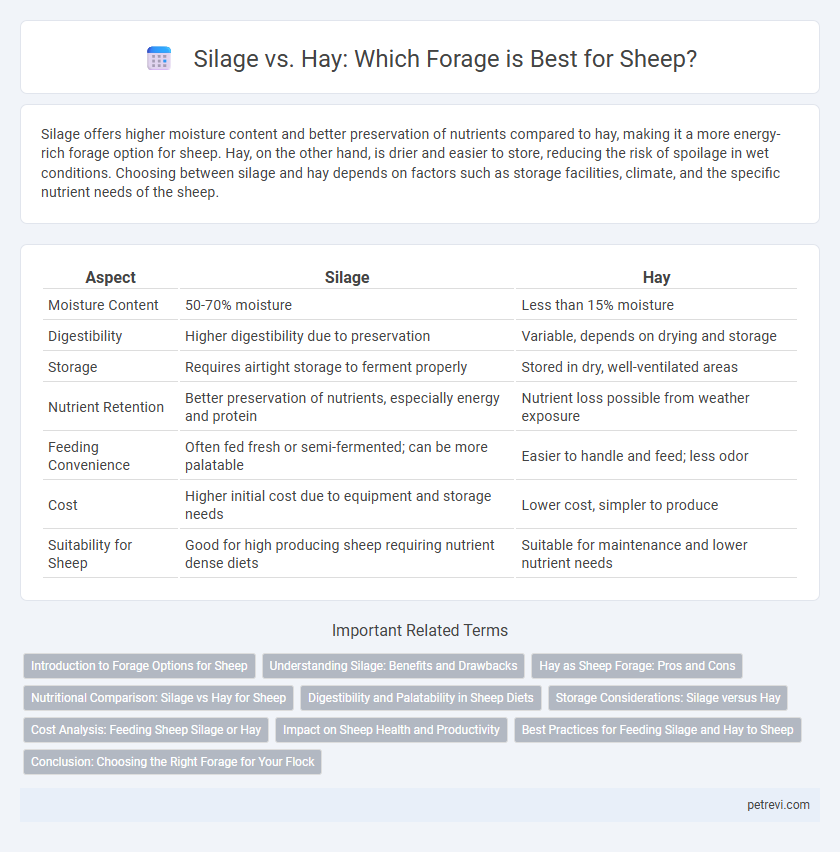Silage offers higher moisture content and better preservation of nutrients compared to hay, making it a more energy-rich forage option for sheep. Hay, on the other hand, is drier and easier to store, reducing the risk of spoilage in wet conditions. Choosing between silage and hay depends on factors such as storage facilities, climate, and the specific nutrient needs of the sheep.
Table of Comparison
| Aspect | Silage | Hay |
|---|---|---|
| Moisture Content | 50-70% moisture | Less than 15% moisture |
| Digestibility | Higher digestibility due to preservation | Variable, depends on drying and storage |
| Storage | Requires airtight storage to ferment properly | Stored in dry, well-ventilated areas |
| Nutrient Retention | Better preservation of nutrients, especially energy and protein | Nutrient loss possible from weather exposure |
| Feeding Convenience | Often fed fresh or semi-fermented; can be more palatable | Easier to handle and feed; less odor |
| Cost | Higher initial cost due to equipment and storage needs | Lower cost, simpler to produce |
| Suitability for Sheep | Good for high producing sheep requiring nutrient dense diets | Suitable for maintenance and lower nutrient needs |
Introduction to Forage Options for Sheep
Silage and hay are two primary forage options commonly used in sheep nutrition, each offering distinct benefits for maintaining animal health and productivity. Silage provides high moisture content and preserves nutrients through fermentation, making it a valuable feed source during wet or cold seasons. Hay, on the other hand, is dried forage rich in fiber and essential nutrients that supports rumen function and is easily stored for long periods.
Understanding Silage: Benefits and Drawbacks
Silage offers high moisture content and enhanced nutrient preservation, making it a valuable forage option for sheep during periods of scarce fresh pasture. Its fermentation process improves digestibility and energy availability but requires careful management to prevent spoilage and mold growth, which can threaten sheep health. Compared to hay, silage provides superior palatability and retains more vitamins and minerals, yet its storage demands and risk of effluent runoff necessitate proper infrastructure and handling expertise.
Hay as Sheep Forage: Pros and Cons
Hay serves as a crucial forage option for sheep, offering high fiber content and ease of storage, which supports rumen health and year-round feeding availability. However, hay's nutritional quality can vary greatly depending on harvest timing and preservation methods, possibly requiring supplementation to meet all dietary needs. Compared to silage, hay is less prone to spoilage but may generate dust that can affect respiratory health in sheep.
Nutritional Comparison: Silage vs Hay for Sheep
Silage contains higher moisture content and preserves more nutrients like protein and energy compared to hay, making it a more digestible forage option for sheep. Hay, while lower in moisture, provides a more concentrated source of fiber and is easier to store long-term without spoilage. Choosing between silage and hay depends on the sheep's nutritional needs and the availability of storage facilities to maintain forage quality.
Digestibility and Palatability in Sheep Diets
Silage offers higher digestibility compared to hay due to its fermentation process, which enhances nutrient availability and promotes efficient rumen function in sheep. Palatability tends to be greater in silage, encouraging better feed intake and supporting optimal growth and milk production. However, hay provides a more stable nutrient profile and is less prone to spoilage, making it a reliable forage option for maintaining consistent sheep health.
Storage Considerations: Silage versus Hay
Silage offers superior moisture retention through airtight fermentation, minimizing nutrient loss and allowing storage in plastic-wrapped bales or silos for up to 12 months. Hay requires dry conditions and protection from rain to prevent mold and nutrient degradation, typically stored in well-ventilated barns or covered stacks to maintain quality. Proper storage of silage reduces feed spoilage risks, whereas hay demands vigilant moisture management to preserve its fiber and energy content for optimal sheep nutrition.
Cost Analysis: Feeding Sheep Silage or Hay
Silage generally offers a more cost-effective feeding option for sheep compared to hay due to its higher moisture content and reduced storage losses, resulting in less feed waste. The initial investment in silage production can be higher because of the need for specialized equipment and airtight storage, but lower feed replacement rates often offset these costs over time. Hay, while easier to handle and store, typically suffers from nutrient degradation and weather-related losses, increasing overall feeding expenses for sheep producers.
Impact on Sheep Health and Productivity
Silage offers higher moisture content and preserves nutrients more effectively than hay, promoting better digestion and increased feed intake in sheep. Hay provides a more fibrous texture that supports rumen function and prevents digestive disturbances, but may lack some vitamins and energy found in silage. Selecting the appropriate forage type impacts wool growth, weight gain, and overall health by balancing nutrient density and gut health for optimal sheep productivity.
Best Practices for Feeding Silage and Hay to Sheep
Silage and hay serve as essential forage options for sheep, with silage offering higher moisture content and better nutrient preservation, while hay provides long-term storage and fiber benefits. Best practices for feeding silage include ensuring proper fermentation to avoid spoilage and gradually introducing it to sheep diets to prevent digestive issues. When feeding hay, select high-quality, mold-free bales, and monitor intake to maintain optimal fiber levels and promote healthy rumen function.
Conclusion: Choosing the Right Forage for Your Flock
Silage offers higher moisture content and better palatability, promoting improved intake and digestion in sheep compared to hay. Hay provides a stable, long-lasting feed option with lower risk of spoilage, ideal for storage and convenience. Selecting the right forage depends on flock needs, storage capacity, and nutritional goals to optimize sheep health and productivity.
Silage vs Hay for Sheep Forage Infographic

 petrevi.com
petrevi.com